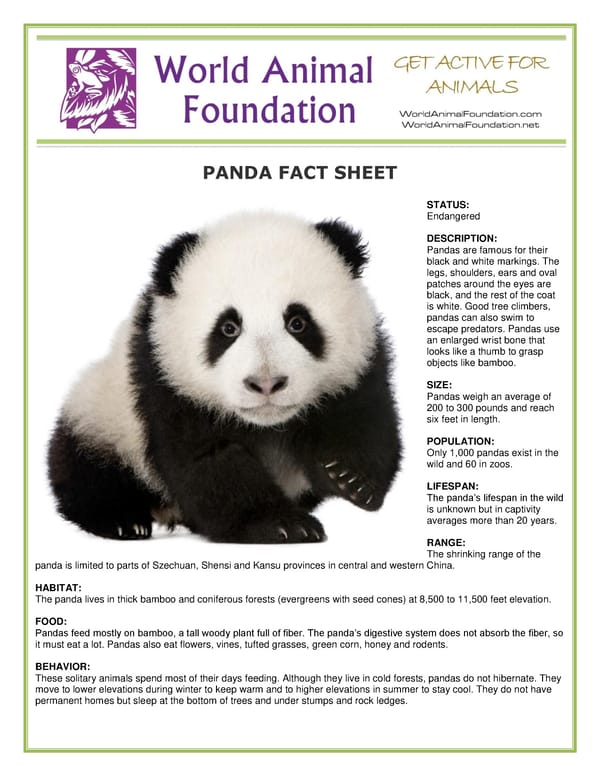64118171068e4de825c3f8e8panda (1)
PANDA FACT SHEET STATUS: Endangered DESCRIPTION: Pandas are famous for their black and white markings. The legs, shoulders, ears and oval patches around the eyes are black, and the rest of the coat is white. Good tree climbers, pandas can also swim to escape predators. Pandas use an enlarged wrist bone that looks like a thumb to grasp objects like bamboo. SIZE: Pandas weigh an average of 200 to 300 pounds and reach six feet in length. POPULATION: Only 1,000 pandas exist in the wild and 60 in zoos. LIFESPAN: The panda’s lifespan in the wild is unknown but in captivity averages more than 20 years. RANGE: The shrinking range of the panda is limited to parts of Szechuan, Shensi and Kansu provinces in central and western China. HABITAT: The panda lives in thick bamboo and coniferous forests (evergreens with seed cones) at 8,500 to 11,500 feet elevation. FOOD: Pandas feed mostly on bamboo, a tall woody plant full of fiber. The panda’s digestive system does not absorb the fiber, so it must eat a lot. Pandas also eat flowers, vines, tufted grasses, green corn, honey and rodents. BEHAVIOR: These solitary animals spend most of their days feeding. Although they live in cold forests, pandas do not hibernate. They move to lower elevations during winter to keep warm and to higher elevations in summer to stay cool. They do not have permanent homes but sleep at the bottom of trees and under stumps and rock ledges.

OFFSPRING: After a gestation period of 125 to 150 days, a mother panda gives birth to one or two young, but only one survives. Eyes open at six to eight weeks, and the cub starts to move around at three months. Weaned at six months, the cub becomes independent after a year. GENERAL INFORMATION: The giant panda lives in mountainous regions, such as Sichuan and Tibet. Since the latter half of the 20th century, the panda has become an informal national emblem for China, and its image is found on many Chinese gold coins. Despite being taxonomically a carnivore, the panda has a diet that is overwhelmingly herbivorous. The giant panda eats shoots and leaves, living almost entirely on bamboo. Pandas are also known to eat eggs, the occasional fish, and some insects along with their bamboo diet. These are necessary sources of protein. Like other subtropical mammals, the giant panda does not hibernate. For many decades the precise taxonomic classification of the panda was under debate as both the giant panda and the distantly related red panda share characteristics of both bears and raccoons. However, genetic testing seems to have revealed that giant pandas are true bears and part of the Ursidae family. Its closest bear relative is the Spectacled Bear of South America. Giant pandas are an endangered species, threatened by continued habitat loss and by a very low birthrate, both in the wild and in captivity. Poaching is uncommon; killing a panda was punishable in China by death until a 1997 law changed the penalty to 20 years imprisonment. The giant panda has an unusual paw, with a "thumb" and five fingers; the "thumb" is actually a modified sesamoid bone. The giant panda has a short tail, approximately 15 cm long. The giant panda has long been a favorite of the public, at least partly on account of the fact that the species has an appealing baby like cuteness that makes it seem to resemble a living teddy bear. The fact that it is usually depicted reclining peacefully eating bamboo, as opposed to hunting, also adds to its image of innocence. Though the giant panda is often assumed docile because of their cuteness, they have been known to attack humans, usually assumed to be out of irritation rather than predatory behavior. Giant pandas can usually live to be 20 30 years old. THREATS: Habitat loss to increasing human populations; poaching; periodic bamboo die-offs. CAPTIVITY: While zoos and aquariums may appear to be educational and conservation-oriented, most are designed with the needs and desires of the visitors in mind, not the needs of the animals. Many animals in zoos and aquariums exhibit abnormal behavior as a result of being deprived of their natural environments and social structures. Some zoos and aquariums do rescue some animals and work to save endangered species, but most animals in zoos were either captured from the wild or bred in captivity for the purpose of public display, not species protection. The vast majority of captive-bred animals will never be returned to the wild. When the facility breeds too many animals they become "surplus" and often are sold to laboratories, traveling shows, shooting ranches, or to private individuals who may be unqualified to care for them. PROTECTION: *Cites Appendix I, Endangered Species Act *Convention on International Trade in Endangered Species of Wild Fauna and Flora, an international treaty with more than 144 member countries. Appendix I listed species cannot be traded commercially. Appendix II listed species can be traded commercially only if it does not harm their survival.